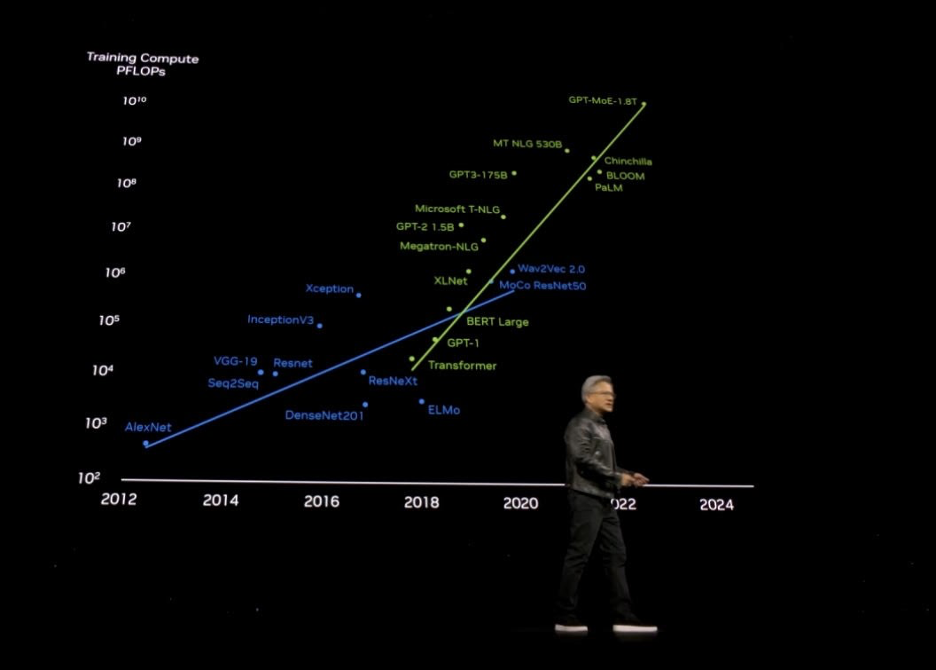
NVIDIA’s annual GTC event was held in San Jose, California, the week of March 18, 2024. Billed as the “Woodstock of AI,” the event went far to highlight the company’s continued progress in AI, leveraging its leadership in GPUs to create an end-to-end platform that includes silicon, software, and curated large language models. Connectivity is a crucial element in NVIDIA’s AI strategy execution, and there were both networking and mobile telecommunications announcements that warrant further examination.
X800 Series Networking Switches
The new X800 Series of networking switches and accompanying acceleration software is designed to support connectivity at scale for AI workloads. The company claims that its two initial switch offerings are the first to support 800Gb/s throughput, representing a significant overall improvement in performance. They include:
- Quantum-X800 InfiniBand comprises a Quantum Q3400 switch and ConnectX-8 SuperNIC. The company claims that it provides a 5x improvement in bandwidth as compared to its previous generation. InfiniBand continues to be NVIDIA’s preferred interconnect architecture, given its investment in the technology via its acquisition of Mellanox for nearly $7 billion four years ago.
- Spectrum-X800 Ethernet comprises the Spectrum SN5600 switch and BlueField-3 SuperNIC. The company positions the Spectrum platform for deployment in multi-tenant generative AI clouds and large enterprises. The use of NVIDIA’s BlueField-3 data processing unit (DPU) also makes a lot of sense, allowing this switch to compete with products from the likes of Marvell and Intel to offload CPU-intensive tasks and improve server performance.
NVIDIA is also bundling acceleration software that includes libraries, software development kits, and management tools to optimize the performance of its hardware. Specifically, these solutions aim to extend the company’s GPU parallel computing tasks to the Quantum-X800 network fabric to provide operational efficiency and support modern applications and services. NVIDIA is smart to offer both InfiniBand and Ethernet flavors of switches. However, I suspect the company will lead with InfiniBand given its staggering performance (and NVIDIA’s vested interest in promoting it). Design wins with infrastructure providers are expected in 2025, and given the attention that CEO Jensen Huang paid to Dell Technologies at GTC, it’s no surprise to learn that Dell, along with Hewlett Packard Enterprise, Lenovo, Supermicro, and others, plan to offer X-800–based solutions.
6G Research Cloud Platform
On the telecom front, NVIDIA announced its 6G Cloud Platform, which aims to infuse AI into next-generation mobile telecommunications. It is designed to be an open architecture that offers researchers a flexible suite of tools to advance radio access network (RAN) infrastructure. It consists of three elements:
- Aerial Omniverse Digital Twin for 6G provides a reference application that simulates complete 6G systems using software-defined RAN and user-equipment simulators. What I find fascinating is the ability to also incorporate terrain and objects that affect signal propagation into the model. NVIDIA claims that researchers will be able to build base-station algorithms based on site data and use it to train AI models to improve efficiency.
- Aerial CUDA-Accelerated RAN is a software-defined RAN stack that takes advantage of NVIDIA’s parallel computing and programming model; this model was developed for general computing based on the company’s GPU platform. This platform will be useful for testing and measurement, which are important in the design and eventual deployment of mobile networks. Consequently, I believe that researchers and companies including Keysight, National Instruments, Rohde & Schwarz, Viavi, and others will embrace NVIDIA’s accelerated RAN platform to customize and test future 6G networks in real-time scenarios.
- Sionna Neural Radio Framework provides integration of popular machine learning frameworks such as PyTorch and TensorFlow to allow researchers to more easily use NVIDIA’s GPUs and its Sionna link-level research tool for AI- and ML-based wireless simulation exercises. I view this as a packaging exercise, but one that has the potential to accelerate the use of NVIDIA AI hardware and software to optimize telecommunication workloads.
NVIDIA’s efforts with its 6G Research Cloud Platform are well ahead of 3GPP standard-setting for 6G. The platform has the potential to accelerate research related to 6G and improve future mobile network throughput, latency, and device support. Its use of AI has the potential to not only improve transmission efficiency, but also aid in network self-healing and security hardening. NVIDIA is clearly staking an early claim in 6G research and development, which is reinforced because all of the test and measurement players as well as RAN leaders Nokia and Samsung Networks are its ecosystem partners.
Final Thoughts
From my perspective, NVIDIA demonstrated its continued investment in AI-driven networking at GTC 2024. Networking serves as the connective tissue that moves data and feeds the underlying large language models of AI. Generative AI in particular is poised to revolutionize the way enterprises and communication service providers design, test, and deploy networking at scale. NVIDIA seems well positioned to play a pivotal role in making it all a reality.






















































































